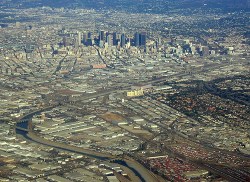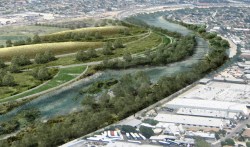This is the third in a four-part series about the Los Angeles River. Read parts one and two.

The confluence of the L.A. River and Arroyo Seco. (Photo by Anarchosyn.)
During our visit to Los Angeles, my wife and I stayed with our friend Liz, a masters of urban planning student and local blogger, in Glassell Park, a hilly neighborhood of Latino and Filipino families on the eastern bank of the Los Angeles River.
Liz’s apartment is within sight of L.A.’s two biggest city parks: Elysian Park, which abuts the north side of downtown and is home to Dodger Stadium, and the mountainous Griffith Park. Ironically, though, Liz and her neighbors on the east side can’t easily reach those public spaces, due to two huge barriers: the 10 lanes of speeding traffic on Interstate 5, and immediately adjacent, the concrete expanse of the Los Angeles River.
That doesn’t mean it’s impossible to enjoy the parks and the river. It just takes some initiative. During our visit, Liz led a tour of her neighborhood in the vicinity of the Arroyo Seco, a major tributary that drains the San Gabriel Mountains and the city of Pasadena and meets the L.A. River just northeast of downtown. The confluence of the two rivers, and the reliable year-round water supply it afforded, is what led the first Spanish settlers to lay out their new town nearby, around the historic Los Angeles Plaza.
My favorite Los Angeles nature writer, Jenny Price, has called the confluence “one of the ugliest, most devastated spots on the Los Angeles River,” which is really saying something.
From a nearby light rail station, Liz took us a few blocks through a mess of gas stations and drive-through restaurants under the tangle of viaducts at the junction of I-5 and State Highway 110 — a confluence with which most Angelenos are much more familiar. There’s actually an official “Confluence Park” here. It was empty when we walked past, not to mention landlocked from the actual rivers, which are a block and a half away and out of sight. The Santa Monica Mountains Conservancy has plans to someday expand this park toward the riverbanks and improve public access. For now, Confluence Park is a pretty bleak place.

Downtown L.A. from the air — can you find the river? (Photo by Ron Reiring.)
As we walked under the 110, Liz suddenly disappeared into a hidden alley. We followed her up a trash-strewn staircase, which led, improbably, to the highway’s median strip.
“So there’s a sidewalk here,” Liz shouted to us, struggling to be heard above the traffic noise. “This was the first freeway built in Los Angeles, from downtown to Pasadena. And since they’d never built a freeway before, they assumed that people would naturally want to take a pleasant stroll alongside it, and take in the view of the rivers.”
She said this with a smirk — the “views” today are pretty different from what those architects had imagined. From the sidewalk, which was strewn with the debris of car crashes, a vista of the river’s vast concrete ditch strobed behind three lanes’ worth of freeway traffic.
This is the stretch of river most frequently used as a location for movie car chases. It looks like a secret freeway with no traffic — the stuff of Hollywood fantasies. Beyond the riverbanks were other moats of industrial infrastructure: Busy railroad lines ran along both banks, plus high-voltage power lines, and multiple chain-link hurdles to keep people out.
From up here, it was apparent that one of the biggest obstacles to restoring the river might be reminding people that it’s actually there.
Groups like the Audubon Society, which runs a nature center in nearby Debs Park and hosts bilingual family programs with a focus on the watershed, and The River Project, which leads guided paddling trips on the river (they’re crowdfunding trips for local at-risk and underserved students, if you’re interested in helping), have been making concerted outreach efforts, particularly to school kids in the surrounding neighborhoods.
Meanwhile, consideration of the Los Angeles River’s watershed is making it into more and more of the city’s official plans, thanks to the pioneering Los Angeles River Revitalization Master Plan. Completed in 2007, the Master Plan is “a 25 to 50-year blueprint … to make the River one of the City’s most treasured landmarks and a catalyst for a sustainable environment.”

A rendering from the Master Plan showing proposed new riverbanks and wetlands at Taylor Yard, an abandoned railroad siding near Elysian Park.
The document itself includes dozens of inspirational architectural renderings that superimpose gravel sandbars, greenery, and happy crowds of walkers and cyclists over photos of the existing paved river channels.
As you’d expect, the plan talks about wildlife habitat and flood control. But there’s also a chapter about integrating the river and its ecosystem functions into surrounding neighborhoods, and another chapter that focuses on environmental justice, and the possibilities of leveraging the revitalized river as a catalyst to clean up pollution and encourage economic development in low-income neighborhoods.
With this blueprint, the city is slowly acquiring little-used or abandoned industrial lots and railroad sidings where new parks, transit districts, and flood-control wetlands might be built. Several new wetland parks have already opened and are already helping to make the L.A. River cleaner and more wild. The latest riverside park, in the Los Feliz neighborhood, just broke ground last week.
In one of the more ambitious proposals, the Friends of the Los Angeles River have suggested a massive redevelopment of Piggyback Yard, a large railroad siding adjacent to downtown, to transform it into a populous transit-oriented and nature-oriented neighborhood surrounding a wide, unpaved floodplain.

An architect’s rendering of a restored Piggy Back Yard.
The architectural drawings show the river at the center of a cohesive, verdant neighborhood in downtown Los Angeles. In this vision, the river isn’t a barrier on the edge of things; it’s the front door of a new gateway to the city.
It’s an inspiring image, but for now, like the Confluence Park, it’s not much more than that. Piggyback Yard is still a busy node of freight traffic on the rail lines that girdle the river from downtown to the Port of Long Beach, at the river’s mouth. The river may tie the city together in a common watershed, but these railroads knit a much more powerful connection between the industries of Los Angeles and the hungry consumers of the global economy.
In my next post, I’ll talk about the river’s home stretch toward the ocean, through the working landscapes of the lower Los Angeles basin.




